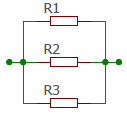Resistors in Parallel
Calculator and formulas for calculating parallel connected resistors
Parallel Resistance Calculator
Input Format
Enter the resistance values separated by semicolons.
Example: 100; 220; 470
|
|
Parallel Circuit

Parallel connection of resistors
Properties
- Same voltage across all resistors
- Total current is the sum of partial currents
- Total resistance is always smaller than the smallest individual resistor
Basic Formula
Special Cases
Formulas for Parallel Circuits
General Formula
For n resistors:
Product Formula (2 resistors)
Simplified formula for two resistors:
Equal Resistors
When all n resistors are equal:
|
|
Practical Examples
Example 1: Three different resistors
Given: R₁ = 4Ω, R₂ = 6Ω, R₃ = 12Ω
✓ Check: 2Ω < 4Ω (smallest resistor)
Example 2: Two equal resistors
Given: Two 100Ω resistors in parallel
For equal resistors: Rtotal = R/n
Example 3: Practical application - Reduce resistance
Task: A 470Ω resistor should be reduced to about 150Ω. What resistor must be connected in parallel?
Current Distribution and Applications
Current Distribution in Parallel Circuits
In a parallel circuit, the total current divides inversely proportional to the resistance values. Current flows preferentially through the smaller resistance.
Current Distribution Formula
Common Applications
- Electrical lighting: Lamps in house installations
- Electronics: Voltage dividers and bias circuits
- Measurement technology: Shunt resistors for current measurement
- Power matching: Reduction of total resistance
Important Note
When connecting resistors in parallel, the total power increases because more current flows.
Consider: Load capacity of the voltage source and thermal stress on components!
Memory Rules
- Rtotal is always smaller than the smallest individual resistor
- More current flows through small resistors
- All resistors have the same voltage
- Total power is the sum of individual powers
Input Guidelines for the Calculator
Correct Input
- Format: Separate values with semicolons (e.g. 100; 220; 470)
- Units: Enter all values in the same unit
- Decimal separator: Use comma (,) or period (.)
- Exponents: Not allowed - use 1000 instead of 1E3
- Result: Displayed in the same unit as the input